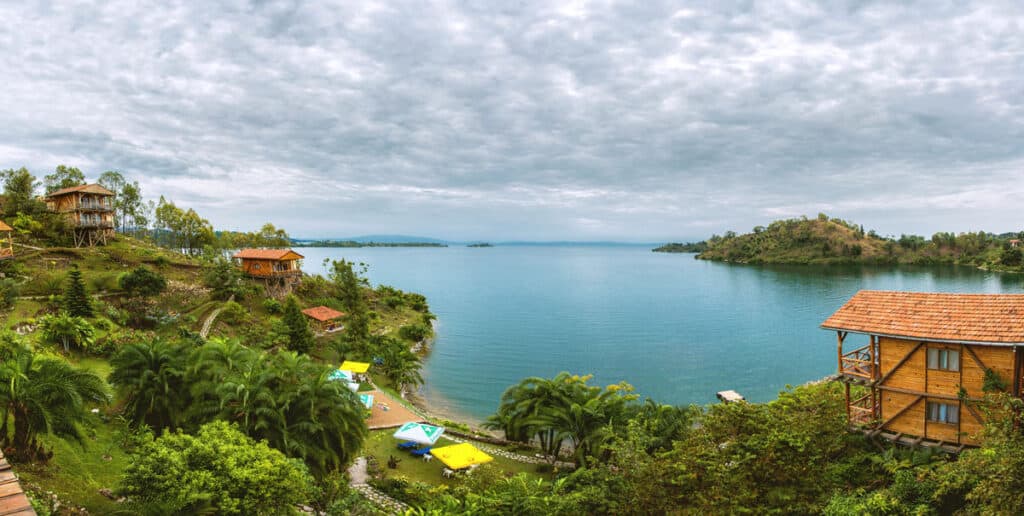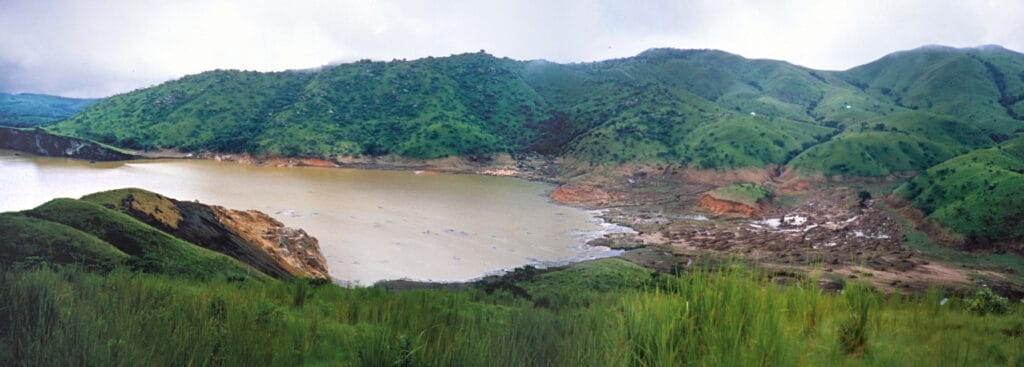Lakes are known to be one of the most beautiful bodies of water on Earth. They provide tons of benefits to humans and offer extensive habitats for various kinds of wildlife, whether marine, aerial, or terrestrial. But what if these magnificent bodies of water that are supposed to provide life are actually meant to take it? There are only three such lakes in the world, and all of them are located in Africa. These lakes are dubbed “killer lakes” because they are deadly. But what would be a more appropriate term is “explosive lakes” because these lakes emit gas from their deep waters up to their surface. However, these gas emissions are not as mild as you may think.
These explosive lakes cause massive eruptions of poisonous gas clouds, called a limnic eruption, that can be fatal for all kinds of life surrounding it. In this article, we will explore all about the three exploding lakes of Africa, how they became so deadly, and their true, tragic stories.
1. Lake Kivu
What is Lake Kivu?

Lake Kivu explodes in a rare limnic eruption, dispersing deadly chemicals into the atmosphere.
©iStock.com/caglarmogultay
Lake Kivu is one of several lakes lining the East African Rift Valley, where tectonic forces progressively pull the African continent apart. It lies on the boundary between Rwanda and the Democratic Republic of the Congo. The infamous African lake covers 1,040 square miles or 2,700 square kilometers of surface area and is one of the largest lakes on the continent. It measures 55 miles or 90 kilometers long from north to south. Sitting at an elevation of roughly 4,790 feet or 1,460 meters, the lake has an average depth of 722 feet or 220 meters, but reaches a maximum depth of 1,558 feet or 475 meters. The coast of Lake Kivu is rocky and rugged, with numerous islets.
Volcanic ramblings along the lake’s northern border built a barrier, separating Kivu from Lake Edward in Uganda, barring its northern outflow and reversing its drainage to the Ruzizi River and into Lake Tanganyika, one of Africa’s largest lakes and among the deepest lakes in the world. Lake Kivu’s beaches are heavily populated. The main towns that settle by the lake’s shores are Bukavu and Goma in Congo and Rwanda’s Gisenyi.
One of the Great lakes and most peculiar lakes in Africa, Lake Kivu, is an exciting subject for scientists and a possible source of both peril and fortune for the millions of people who live nearby due to its odd collection of qualities. Throughout the globe, there are plenty of bodies of water that can be deadly. Yet, most of them do not even equal Lake Kivu’s level of toxicity.
What Makes Lake Kivu Different from Other Lakes?
Lake Kivu may be a picturesque lake, but it behaves differently than most deep lakes, making it lethal. When water at a lake’s surface is chilled, heavy water sinks while warmer, less dense water rises from the deeper parts of the lake. This natural phenomenon is called convection, and it keeps the surface of deep lakes warmer than its depths. Lake Kivu, however, behaves much differently. Circumstances have combined to prevent this mixing at Lake Kivu, giving the lake unique properties – and unforeseen consequences.
Why Does Lake Kivu Explode?
The beautiful Lake Kivu can explode in a rare limnic eruption, dispersing deadly chemicals into the atmosphere. But how does this happen? Lake Kivu explodes because of the ensuing forces within it, which cause the Earth’s crust to erode and volcanic activity to erupt. This triggers the hot springs beneath Kivu to transmit carbon dioxide, hot water, and methane into the lake’s deeper layers.
Bacteria in Lake Kivu convert carbon dioxide (CO2) into methane, a highly combustible gas that might cause an even more devastating lake explosion. The molten rock beneath the lake spews carbon dioxide into the water. Like carbonation in a can of soda, the extreme pressure at the bottom of the deep lake enables gasses to be dissolved into the water. The water absorbs the gas until it can no longer do so. As a result, the lake then explodes like soda from a shaken can due to events such as a landslide, earthquake, or heavy rainstorm. These gasses would usually bubble to the surface, but due to Lake Kivu’s incredible depth, the lake keeps them submerged.
But Lake Kivu is more than a scientific puzzle. Researchers are concerned that its peculiar stratification and the trapped CO2 and methane in its deeper levels could be a calamity waiting to happen.
2. Lake Nyos

In 1986, a limnic eruption happened as Lake Nyos physically exploded and claimed the lives of 1,700 people.
©United States Geological Survey, Public domain, via Wikimedia Commons – License
What is Lake Nyos?
Lake Nyos is a crater lake located in Cameroon’s Northwest Region. It is a deep lake situated high on the face of an extinct volcano in the Oku volcanic plain, which is part of the Cameroon volcanic activity line. The lake’s waters are held back by a volcanic dam. Although this lake may seem like a typical lake to many, it is one of the world’s deadliest lakes. A 1986 incident, known globally as the Lake Nyos Disaster, shook Africa when the lake suddenly released a massive cloud of carbon dioxide in the middle of the night, suffocating over 1,700 people living around the lake and killing 3,500 of the land’s livestock. Most of its nearby towns and villages were abandoned after the event.
What Happened to Lake Nyos in 1986?
Thinking of it as an average day, the town of Lower Nyos in Cameroon had a busy market day on August 21, 1986, and most people retired to bed early that evening. An odd sound of explosion suddenly went up in the air. The following morning, lifeless bodies of residents lay on the town’s grounds, but all of them did not have any wounds. Even insects were not saved.
A limnic eruption happened as Lake Nyos physically exploded, blasting a fountain of water over 300 feet above the ground and causing a small tsunami-like wave. At 60 miles per hour, tons of carbon dioxide erupted, smothering individuals up to 9.3 miles away. Everyone struggled to comprehend what had occurred in the days following the disaster. But what was the culprit?
An unusual volcanic phenomenon related to Lake Nyos was revealed as the actual cause. The Cameroon Volcanic Line, a 950-mile series of volcanoes and crater lakes, encompasses Lake Nyos. Its origins aren’t totally clear. But it’s likely that during the early stages of Africa’s split from South America, a third rift zone formed with some volcanic activity but failed to develop into a true rift and oceanic basin.
What Makes Lake Nyos so Deadly?
The reason behind Lake Nyos’ gas explosion can be summed up in two words: carbon dioxide. Volcanic activity at depth emits carbon dioxide gas into the rock layers in such volcanic lakes. Carbon dioxide is then slowly absorbed into the groundwater as it flows through the rock. When this happens beneath a lake, the carbon dioxide is absorbed into the lake’s lower depths, filling the water with CO2. This was not the case at Lake Nyos, though. The embedded carbon dioxide was stored until it was suddenly released, resulting in a spontaneous, rapid, and quiet calamity that claimed the lives of almost 1,700 people.
Such deadly lakes are uncommon because they require particular circumstances to emerge. In its case, the lake must be volcanic in origin and must be deep enough so that the pressure on the bottom holds the gasses subdued in the water.
3. Lake Monoun

Lake Monoun is a deadly African Lake that exploded in 1984, killing 37 people.
©Prosper Mekem / CC BY-SA 4.0, via Wikimedia Commons – License
What is Lake Monoun and Why is it Deadly?
A crater lake in Cameroon’s West Province, Lake Monoun is another deadly African Lake that exploded in the 1980s. A limnic eruption at the lake happened on August 15, 1984, resulting in the emission of a massive volume of carbon dioxide that took the lives of 37 people. Some of the passengers in a truck transporting twelve persons were among the victims. The truck’s engine stopped working due to a lack of air, and the occupants inside escaped but died eventually from suffocation. The fatalities were unexplained at first, and terrorism was regarded as a possible cause. Yet, the currently accepted explanation was based on further examination and a similar event two years later at Lake Nyos.
Lake Monoun is one of the three lakes in the world, along with Lake Nyos and Lake Kivu, that have substantial concentrations of gas absorbed and subdued deep beneath the lake’s water surface with the proper conditions for a limnic eruption.
A limnic eruption occurs when dissolved CO2 erupts from deep lake waters, generating a gas cloud that can suffocate wildlife, cattle, and humans. Because rising CO2 displaces water, a limnic eruption could result in a tsunami. Researchers believe that limnic eruptions can be triggered by volcanic activity, earthquakes, and other combustible occurrences. Limnically active lakes, called exploding lakes, are lakes that experience this type of activity. Only three exploding lakes are known to be on Earth, all of which can be found in Africa.
The photo featured at the top of this post is © iStock.com/atosan
Thank you for reading! Have some feedback for us? Contact the AZ Animals editorial team.






